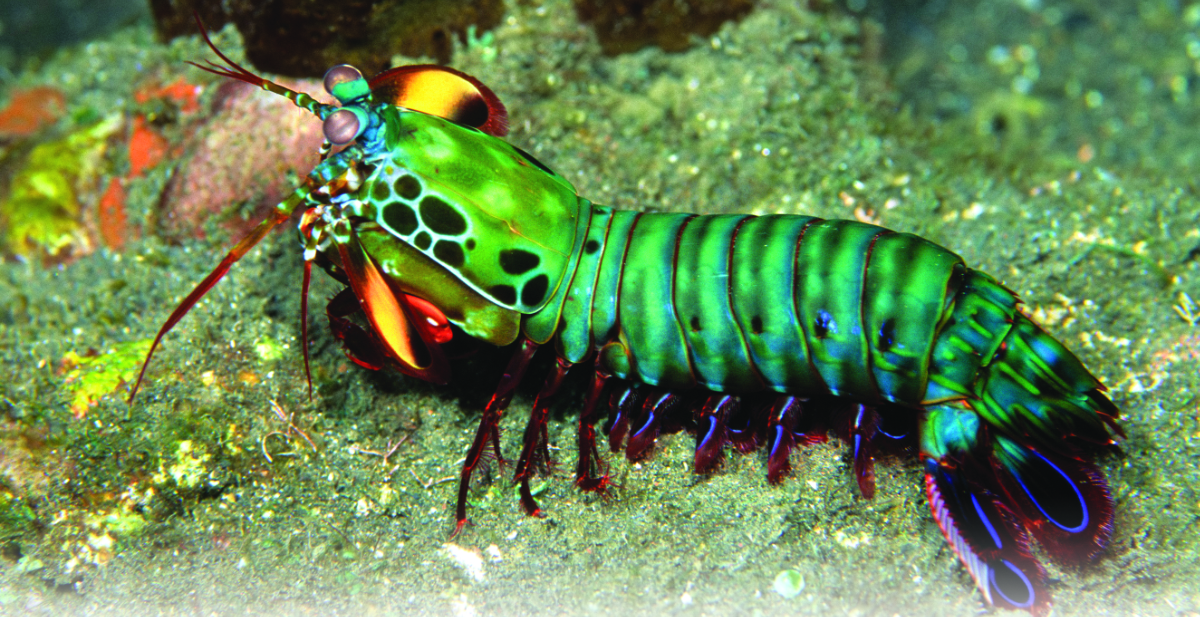Shrimpy superboxer
This is the pre-publication version which was subsequently revised to appear in Creation 30(2):12–13.

For pound-for-pound boxing records, look not to ‘Sugar’ Ray Robinson or Rocky Marciano. Rather, the 6–10 cm (2.35–4 inches) long mantis shrimp or stomatopod has the fastest punch of all. Crustacean1 expert Shiela Patek and her team at the University of California, Berkeley, needed high-resolution video at 5,000 frames per second to analyse this.2 They showed that the peacock mantis shrimp (Odontodactylus scyllarus) can punch with a force ‘well over a hundred times the mantis shrimp’ body weight.’2
The club-like limb reaches a top speed of 14–23 metres per second (31–51 mph), and a peak acceleration of 65–104 km/s2 (6600–10,600 g, where 1 g is the acceleration due to gravity; astronauts and jet fighter pilots will pass out at only 10 g).3 They use this to crush the shells of snails they prey on, and in captivity, have shattered the glass walls of their tanks.2
Catapult
To reach such speeds, ordinary muscles won’t do. Rather a catapult mechanism is required—that is so lots of energy can be built up in an elastic material, then released suddenly. Thus the shrimp has a specialized saddle-shaped spring in the hinge of the shrimp’s striking appendage.
Its shape has the technical name hyperbolic-paraboloid, but resembles a Pringles chip. It is a very strong and efficient structure. Indeed, it is used in engineering and architecture because it distributes stresses and resists buckling, while the nautilus uses this structure to strengthen its shell.1 However, no other animal uses it as a spring.3
But a spring isn’t enough for a catapult. There must also be muscles to load it, and a click or latch mechanism to release it. If all these parts were not in place, the mechanism would not work at all. This could not have formed by random small changes and natural selection, because the latter would not work since the changes confer no advantage until the whole system is complete.
Bubble blast
In fact, each blow is a one-two punch. Dr Patek’s team found that there were two force peaks for every strike, less than half a millisecond apart. The second one is caused by a destructive process called cavitation.4 This is where high-speed water flows irregularly, causing tiny bubbles of water vapour to form. When the pressure is restored, they collapse at supersonic speeds, forming shock waves with huge pressures, as well as sound and even light. In fact, the cavitation forces may be almost four times those of the actual limb impact. Cavitation can destroy steel surfaces and boat propellers, and would have destroyed hard rock during the Flood.5 Even the shrimp’s heel is not immune—even though it contains tough minerals, they moult frequently to regenerate.3
Chance or design?
The mantis shrimp with the catapult puncher that exploits cavitation defies evolution. But how does crushing snails fit with a creation described as ‘very good’? First, invertebrates such as snails are not ‘living’ in the sense of being ‘soulish’, as vertebrates are—the Bible never calls them nephesh chayyāh (Hebrew נֶפֶשׁ חַיָּה living souls/creatures). Indeed, scientific evidence suggests that invertebrates do not experience pain.6 Second, this could have been a latent feature programmed into the genes by the Creator who foreknew the Fall.7
Super sight

The mantis shrimp also ‘has one of the world’s most complex colour vision systems’, according to Justin Marshall of Queensland University’s research centre for vision (Australia).1 While humans have three different types of colour receptor (red, green and blue), the shrimp has 12. Four of these can see in the ultraviolet, which we can’t.2 Furthermore, they can tune their vision with special transparent colour filters to compensate for the way water absorbs different colours differently.3
Dr Marshall said that understanding the shrimp’s eyes could help us design cameras for satellites. ‘Instead of throwing a shrimp on the Barbie, I want to put a prawn into space.’1
- Prawn of a new era, Sunday Telegraph, 16 September 2001.
- Marshall, N.J. and Oberwinkler, J., The colourful world of the mantis shrimp, Nature 401(6756):873–874, 1999; this shrimp was Neogonodactylus oerstedii.
- Cronin, T.W., Marshall, N.J., Caldwell, R.L., Tunable colour vision in a mantis shrimp, Nature 411(6837):547–548, 2001; this shrimp was Haptosquilla trispinosa. Long wavelength light such as red is absorbed more than short wavelengths like blue, so very little red reaches the shrimps in deep water, so its filters are tuned to shorter wavelengths.
- Ceurstemong, Sandrine, Satellite-life eyes give mantis shrimp unique vision, New Scientist 23 January 2014; after Science | DOI:10. 1126/science.1245824.
Update, 26 October 2009: these eyes could also revolutionize DVD technology, according to ‘Sexy’ shrimp eyes help DVD technology:
They can see in 12 primary colours, four times as many as humans, and can also detect different kinds of light polarization — the direction of oscillation in light waves. Now a team at the University of Bristol have shown how the shrimps do it, using remarkable light-sensitive cells that rotate the plane of polarization in light as it travels through the eye.
Manmade devices do a similar thing in DVD and CD players but they only work well for one colour, while the shrimp’s eye operates almost perfectly across the whole visible spectrum from near ultra-violet to infra-red. Transferring the same multi-colour ability into a DVD player would result in a machine capable of handling far more information than a conventional one.
“The mechanism we have found in this eye is unknown to human synthetic devices. It works much, much better than any attempts that we’ve made to construct a device,” said researcher Nicholas Roberts. He believes the “beautifully simple” eye system, comprising cell membranes rolled into tubes, could be mimicked in the lab using liquid crystals.
Details of the mantis shrimp research were published in the journal Nature Photonics.
Update, 24 January 2014: more recent research shows that the mantis shrimp are not especially good at fine distinctions in colour. It’s important to note that colour vision requires not only the right eye design to pick up light signals but also the brain to process these signals. Our own ability to discern different colours is the result of our brains processing the relative intensity of the signals from the three types of colour receptors. E.g. yellow light stimulates both the red and green receptors, which is why TV and computer screens can simulate yellow with tiny red and green pixels shining together. A small change in the shade results in a slightly different intensity ratio. This three-pigment system combined with brain processing enables very fine colour discernment.
The mantis shrimp eye is designed instead to identify only the basic colours, but to do so speedily and with minimal requirements on its shrimpy brain. Its 12 different photoreceptors are arranged in a sequence, and when the eye scans an object with a sweeping motion of its eyes, the image will be picked up by different receptors that will respond differently. The colour is determined by the sequence of responses instead of intensity comparisons.
All the same, this is still an intricate design, and Dr Marshall says “I tried to convince NASA that they designed satellites wrong and should be using the [mantis shrimp] design for their sensors.” He also thinks it could be good for DVD technology. While normal DVDs use a red lasers, and Blu-Ray disks use a blue laser, “Mantis shrimp could inspire a ‘rainbow ray’ disc, where information can be packed into the entire spectrum. It would allow a lot more data to be stored in the same amount of space.”3
Re-posted on homepage: 29 March 2023
References
- Weston, P., Creation’s crustaceans, Creation 23(3):10–13, 2001; creation.com/crust. Return to text.
- Sanders, R., Mantis shrimp may have swiftest kick in the animal kingdom, UCBerkeley News, www.berkeley.edu/news/media/releases/2004/04/21_shrimp.shtml, 21 April 2004. Return to text.
- Patek, S.N., Korff, W.L. and Caldwell, R.L., Deadly strike mechanism of a mantis shrimp, Nature 428(6985):819, 22 April 2004. Return to text.
- Patek, S.N. and Caldwell, R.L., Extreme impact and cavitation forces of a biological hammer: strike forces of the peacock mantis shrimp Odontodactylus scyllarus, Journal of Experimental Biology 208:3655–3664, 2005. Cavitation is somewhat like boiling. Even non-boiling liquids have some molecules escaping as gas, and some of these molecules return to the liquid. At equilibrium, the gas has a certain vapour pressure. Boiling occurs when the liquid is hot enough to raise its vapour pressure above atmospheric pressure. At high altitude, it takes a lower temperature to boil because the atmospheric pressure. Cavitation takes this a step further: the fast flow of a liquid lowers the pressure by the Bernoulli effect, and when the pressure drops below the vapour pressure, bubbles of vapour are produced. Shallow water is worse because there is less pressure from the weight of the liquid. The damage is caused when the bubble bursts, since the pressure of the surrounding liquid is very high for small bubbles (inversely proportional to the radius). Return to text.
- As long as the water was fast (over 30 m/s, 70 mph) and shallow (under 10 m or 30 feet deep); Cardno, S. and Wieland, C., Clouds, coins and creation: An airport encounter with professional scientist and creationist Dr Edmond Holroyd, Creation 20(1):22–23, 1997; creation.com/holroyd. Return to text.
- ‘Some insects normally show no signs of painful experience at all. A dragonfly, for example, may eat much of its own abdomen if its tail end is brought into the mouthparts. Removal of part of the abdomen of a honeybee does not stop the animal’s feeding. If the head of a blow-fly (Phormia) is cut off, it nevertheless stretches its tubular feeding organ (proboscis) and begins to suck if its chemoreceptors (labellae) are brought in touch with a sugar solution; the ingested solution simply flows out at the severed neck.’ ‘Sensory Reception: Mechanoreception’, Encyclopædia Britannica (Electronic edition on CD). Return to text.
- See also Batten, D. (Ed.), Catchpoole, D., Sarfati, J. and Wieland, C., The Creation Answers Book, chapter 6, Creation Book Publishers, USA; and Q&A: Death and Suffering, creation.com/curse. Return to text.












Readers’ comments
Comments are automatically closed 14 days after publication.